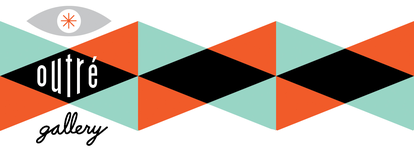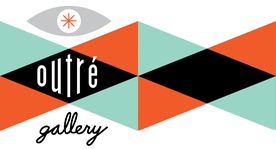Kelly O'Sullivan's paintings deconstruct the gridlines of existence. February 27 2017

Heavily influenced by the discipline of modernism, pattern & textile design of the mid century, Kelly O'Sullivan creates work that is made up of clean and simple shapes based from a grid system. Her work symbolises her relationships with everyday forms, expressing emotion, reflecting experiences and surroundings through the use geometry, colour, pattern, line and repetition. Kelly is particularly interested in the beauty of abstracted form and enjoys deconstructing shapes to create balanced and emotive compositions. Kelly will be showcasing a new collection of original paintings in her upcoming show 'Gridlines' at Outré Gallery, premiering from 6pm to 8pm on April 21 and running through to May 4.
In the body of work for 'Gridlines' Kelly further explores the creation of abstract form through the use of a simple grid system. Kelly says "It's about carving out an abstract form from a simple grid that were originally inspired by form and lines in the natural environment and urban architecture"
A key piece within this exhibition, 'Life Tapestry' plays on the arrangement of our day to day existence paralleled to an artworks composition. In this work, four small pieces of work interact together as one larger work. They are all part of the same original grid and have a corresponding colour palate. They can be reordered in any way and still work as a unit, but they have a different overall feel depending on how they are displayed. Kelly says of the work "It is about how we all have choices in our lives, but the decisions we make ultimately impact on what our life looks like, how it weaves together."
We caught up with Kelly in the lead up to her show 'Gridlines' to find out her ideas behind this new body of work, how modernism has influenced her and what her process is when creating an artwork.
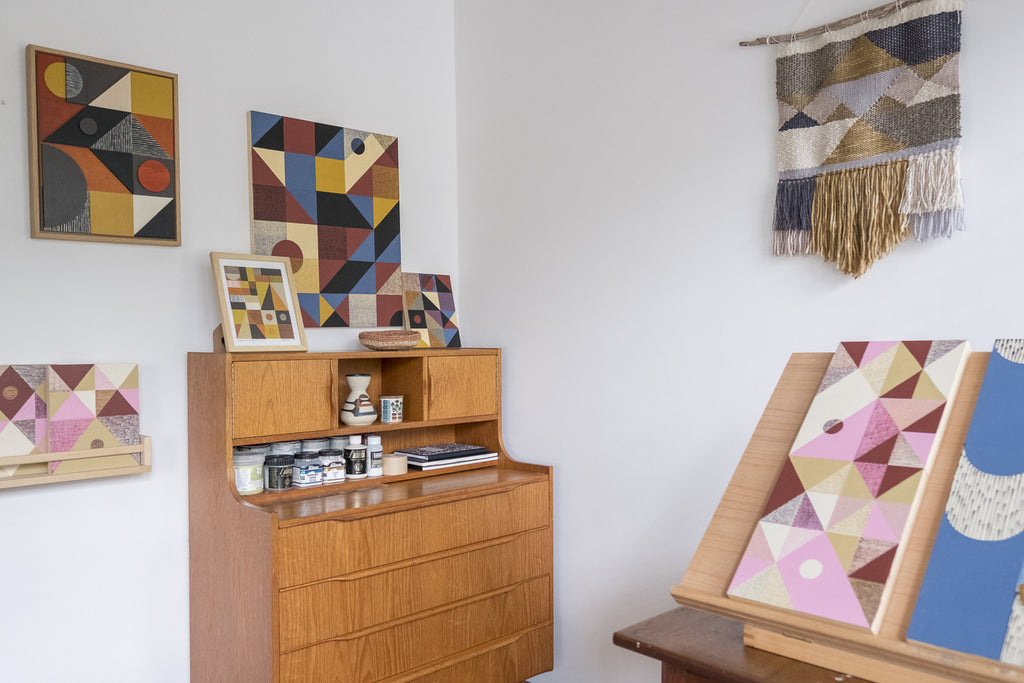
Influenced by the discipline of modernism, pattern & textile design of the mid century - what drew you to this style and how do you think it comes out in your work?
I've always felt an affinity with modernist design, an appreciation of it in all aspects from architecture to furniture and everything in between. It's a period in art which has really resonated with me. I think the thing that resonates with the most is the concept of designer as artist as craftsperson. Many of the artists of the period were creative within different disciplines and they were immersed in their art, design and craft. For example Le Corbusier known for his architecture also was a furniture designer and painter. As a designer, I remember feeling I couldn't be an artist. A few years ago, when I began a yearlong project of painting a 30minute sketch everyday, I quickly realised that the shapes, colours and patterns I was intuitively creating had quite a modernist feel. Also around this time I began weaving and, after a long break from art theory, reacquainting myself with design principles from the Bauhaus. In particular the women artists and weavers who created amazing geometric pieces. A whole new world opened up. I felt a strong affinity with these women. We were using similar shapes, forms and colours and they were using design principles in their art, they were respected in multiple disciplines and it kind of gave me permission in a way to pursue this hybrid of design and art and craft.
I'd like to think Modernism also comes out in my work predominantly through the interaction of colour, line and form. But also the balance and strength of the composition. Becoming a weaver and understanding woven textiles has directly influenced the mark-making, patterning and textures in my work.
Geometric shapes, lines and repetition are the basis of many of your paintings; could you speak about what these represent to you?
I'm conscious of the harmony of balance, of simplicity and restraint, even with the use of repetition I'm beginning with a grid and cutting into it to show form, building shapes from lines and mark-making. I'm interested in the way the audience views the painting, what their eye is drawn to and where their eye can rest. I remember that Klee taught that a painting should be structurally balanced, just like architecture needs to be and that is something that I am really interested in.
In terms of shapes, I have a particular affinity with the circle, triangle and square. They were originally inspired by nature; an abstract form of the sun and moon, pine tree and the square frame, that I see everyday. They have come to be representational of strength, balance, discovery. With the grid representing connection.
I believe that there is a beauty in repetition. It is imperfect and unique brushstrokes working together to create a uniform whole.

Abstract form is a topic you are interested in - what are your thoughts on it and what role does it play in your work?
For me, it's all about developing a visual language that communicates a feeling – not necessarily a representation – to the viewer. It's about being playful with shape and form to convey a feeling, to create visual dynamism and balance, that doesn't literally exist in nature or the real world, despite being inspired by it.
I'm not interested in a specific narrative, I aim to evoke imagination and thought with the viewer. I give clues of inspiration to the viewer through the title but ultimately allow the viewer to find their own meaning.
The colours of your work invoke various emotions - what is the relationship you want to build with the viewer using colour?
Ultimately, I want the viewer to feel good. Maybe even reminded of a different time or place... to give joy.... there's something warm, familiar about midcentury pieces, I hope my work has that too. The interaction of colour constantly inspires me, particularly the way solid colours and layers of coloured pattern interact differently. I try to use different colour combinations that perhaps surprise the viewer but definitely have an understanding of the importance and power of the colour wheel.
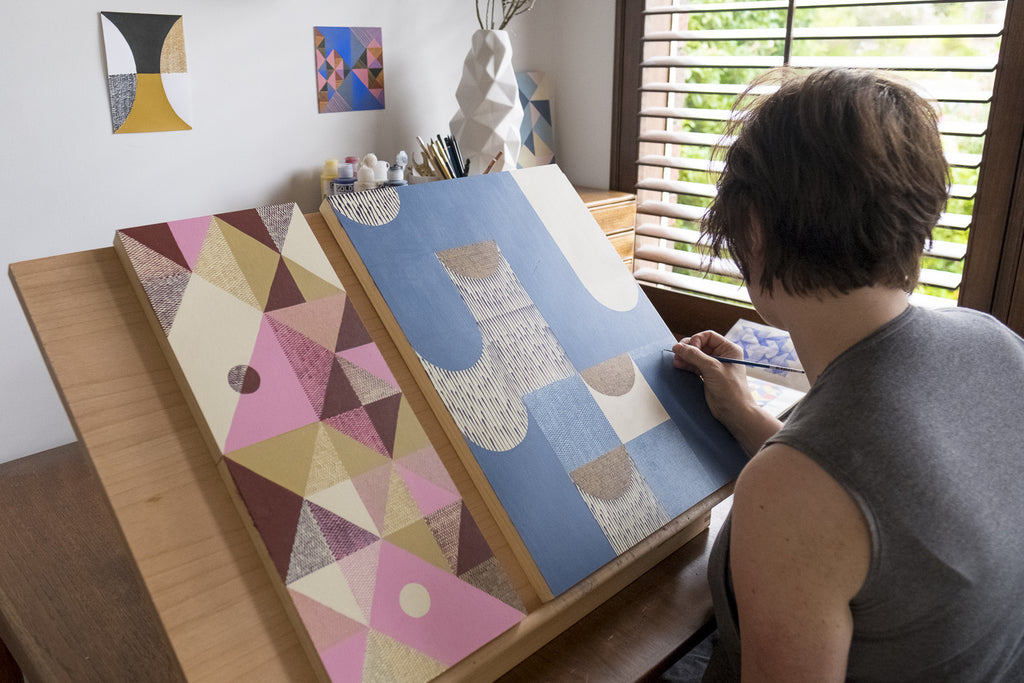
Where do you mostly work from, if in a studio - what’s a typical session in there like for you?
I have a studio at home. It's an ever evolving space. At the moment it is just a room with a desk and a cute little midcentury bureau, but man am I grateful of that space! I have 2 young children so I work early in the mornings or late at nights, and sometimes I can have those precious daylight hours on weekends. Its a juggle but its always worth it to carve out time for art. A typical session is just a couple of hours – but is pure bliss. I'm fortunate that my style and the way that I work means I can work on sections of paintings sporadically. My paintings evolve slowly over time. They are quite meditative.
Could you speak about your preferred mediums to work with?
I predominately prefer acrylic on wood, there's something about the hard surface that I enjoy. It works very well for what I'm trying to achieve. The bounce of the canvas for example, does not to me any favours! I also often leave the raw wood exposed as another element to the work. It's great for the detail of the brushstroke pattern. As is just simply working on a heavy watercolour paper. Either with inks, acrylic or gouache. I like the tooth and whiteness of the paper, which is in contrast with the wood. Recently I have been getting into making reliefs, using wood panels and cutting shapes from ply. Once again I think that has come from the idea of the artist as craftsperson and the desire to 'make'.
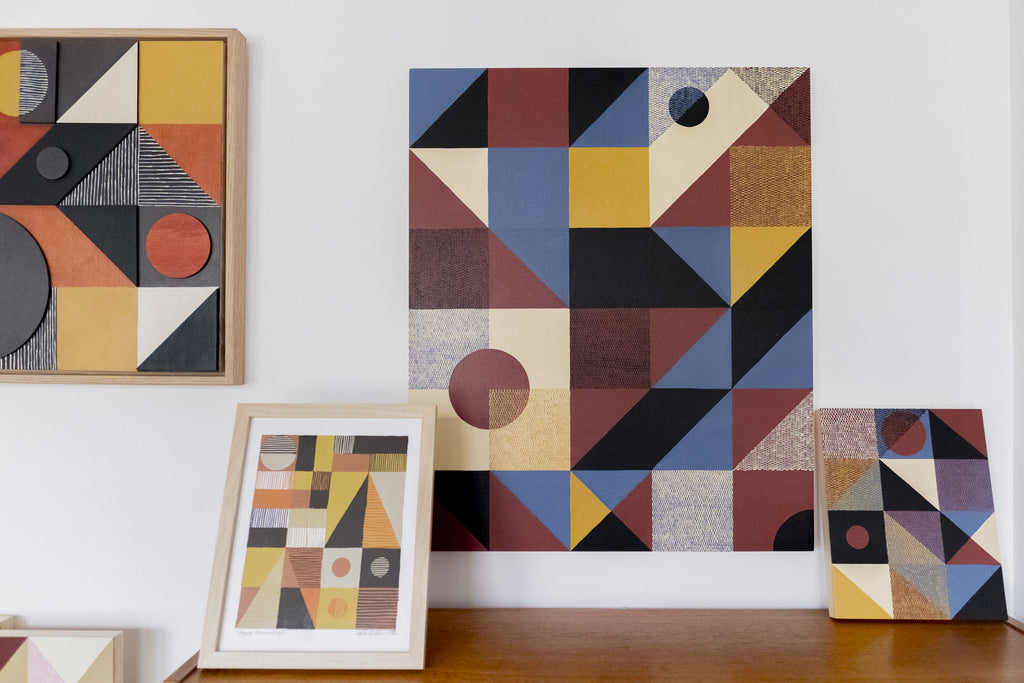
How do you tackle a painting, talk us through your process.
The first step is always to draw a grid. From there I begin pencilling in lines and shapes to indicate where I could go with introducing form, focusing on overall composition. This is usually very simple and at this stage quite flexible. Then I mix 3 or 4 colours that will be my limited palette. I will paint blocks and shapes of the grid one colour at a time. This is the most important part as it defines the entire composition. When all the solids are complete, I add the brushstroke texture, again one colour at a time. I'm interested in balance in both form and colour so by focusing on 1 colour at a time helps. Its very important to get the brushstroke patterning correct on the first go, there is no possibility in painting over it as the texture is still visible underneath. I don't tape any of my work. I'm genuinely not bothered by imperfect edges. Yes it's a hard edge but its an imperfect edge. I prefer the element of the hand. It's painted by a human afterall. It cannot be perfect and why should it be. I think its a reaction against all my past time spent on a computer with frustration at the lack of hands.
You also work at a graphic design firm, where does this fit in creatively; does this work influence your painting or vice versa?
I think my training and experience as a graphic designer, if subconsciously, informs the composition, balance and rhythm of my abstract paintings. I used to think they had to be mutually exclusive but once I realised I didn't have to separate them, everything became so inspiring and I had a new found drive to explore design principles in a painting context – line, form, colour, harmony, contrast, repetition and balance. Definitely using the structure of the grid has been influenced by my work as a graphic designer. On the flip side, my work has evolved over the years and in general, much of my work as a designer carries over the aesthetic of my paintings. I was fortunate enough to interpret music as illustrations for the Adelaide Symphony Orchestra's 2017 season, which definitely has a common thread with my paintings.

What do you enjoy about doing commercially based projects?
Collaborating, helping to solve visual problems, communicating visually, providing solutions that meet someone else's creative needs, not just my own. I'm very fortunate that we take on work that aligns with our values, so we work with the arts industry, community events and small family businesses so it's very rewarding work to be a part of.
You will be exhibiting at Outré Gallery on April 21 - May 4, could you speak about the artworks which will be showing and the concept behind this body of work.
I've titled the show 'Gridlines'. ‘Grid’ references the grid system from where my work begins and also my inspiration of the grid in the landscape (both urban & rural).‘Lines' references the lines & patterning in my work as well as the lines of text that help inspire and give meaning to my work. It's about carving out an abstract form from a simple grid that were originally inspired by form and lines in the natural environment and urban architecture. It's intentionally abstract, with minimal titles to encourage the viewer to interpret the work in their own way and find their own meaning. It's aesthetically about the power of form line colour, composition, to create rhythm, balance, harmony and strength.
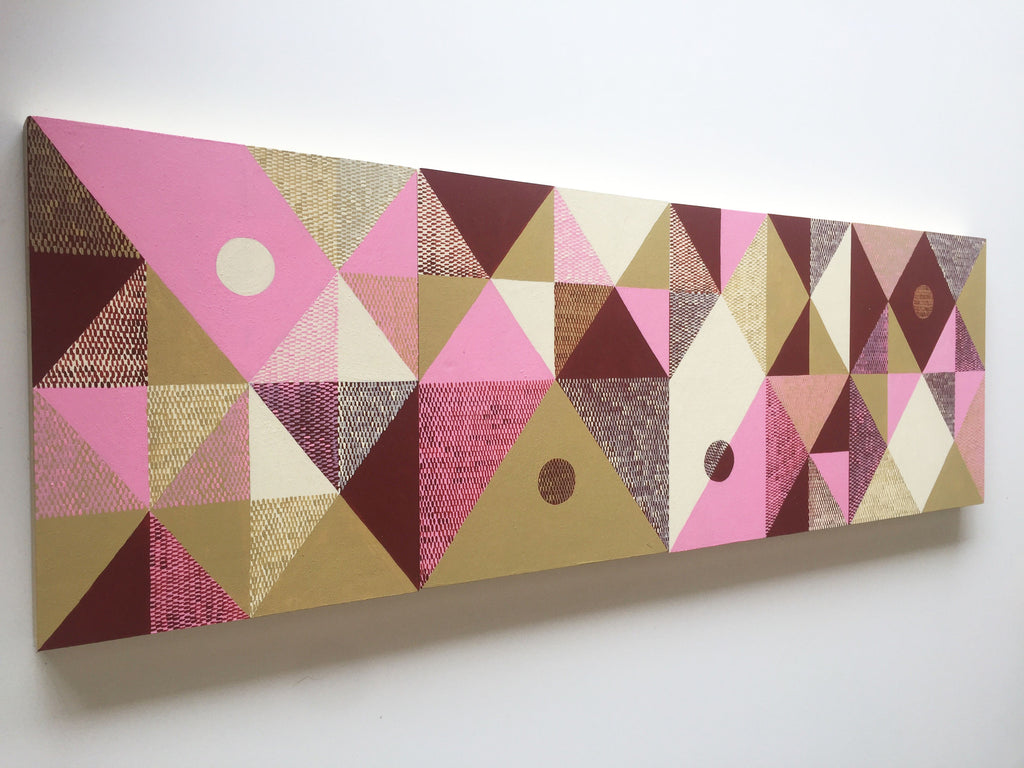
Is there a work in particular you could speak in a bit more detail about?
I have 4 small pieces of work that interact together as one larger work, or work equally on their own individually. They are all part of the same original grid and of the same colour palette. They can be turned around, mixed up and reordered and they still work together as a unit, but have a different overall feel depending on how they are displayed. I wanted to evoke imagination and thought with the viewer, encourage playfulness and a give them a sense that they are part of the process; by deciding how the work is hung, they are effectively curating the composition of the work as a whole. The piece is collectively titled 'life tapestry'. It is about how we all have choices in our lives, but the decisions we make ultimately impact on what our life looks like, how it weaves together.
MELBOURNE OPENING
Exhibition Opening Night Reception.
Friday April 21st, from 6pm to 8pm
exhibition then runs until May 4th.
249 Elizabeth St, Melbourne VIC 3000

